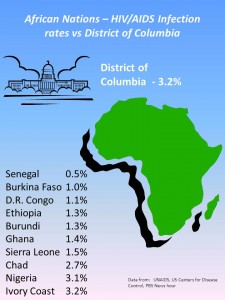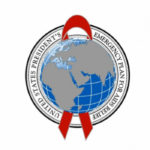 A new report by UNAIDS shows that 19 of the 35 million people living with HIV globally do not know their HIV positive status. While the report highlights how the efforts to increase access to life-saving antiretroviral treatment (ART) are making a difference, there is much more to be done in order to end the epidemic. According to UNAIDS Executive Director Michele Sidebe,
A new report by UNAIDS shows that 19 of the 35 million people living with HIV globally do not know their HIV positive status. While the report highlights how the efforts to increase access to life-saving antiretroviral treatment (ART) are making a difference, there is much more to be done in order to end the epidemic. According to UNAIDS Executive Director Michele Sidebe,
“Smarter scale-up is needed to close the gap between people who know their HIV status and people who don’t, people who can get services and people who can’t and people who are protected and people who are punished.”
By the end of 2013, the estimated number of people accessing ART globally was nearly 13 million, and AIDS-related deaths were at their lowest since the peak in 2005, having declined by 35%. “If we accelerate all HIV scale-up by 2020, we will be on track to end the epidemic by 2030,” Sidebe said. “If not, we risk significantly increasing the time it would take—adding a decade if not more.”
Ending the epidemic by 2030 would avert 18 million new HIV infections and 11.2 million AIDS-related deaths between 2013 and 2030 around the world.
If we accelerate all HIV scale-up by 2020, we will be on track to end the epidemic by 2030
The first of its kind, the UNAIDS Gap Report highlights which countries account for the highest number of new infections; countries that are being left behind and are facing the triple threat of high HIV burden, low treatment coverage and little or no reductions in new HIV infections; and emphasizes the importance of location and population through in-depth regional analysis of HIV epidemics. It also identifies 12 populations at higher risk of HIV. It analyzes reasons for the growing gap between people with access to HIV prevention, treatment, care and support and people who are being left behind; showing how focusing on the underserved and higher risk populations will be the key to ending the epidemic.
Groups at High Risk: HIV prevalence is estimated to be 28 times higher among injecting drug users, 12 times higher among sex workers, 19 times higher among me who have sex with men, and 49 times higher among transgender women than among the rest of the adult population. In sub-Saharan Africa adolescent girls and young women account for one in four new HIV infections.
“There will be no ending AIDS without putting people first,” Mr. Sidebe said. “Without a people-centered approach we will not go far in the post-2015 era.”
 While great strides are being made in reducing the number of people with HIV/AIDS globally, the US must also focus on our own HIV/AIDS epidemic which includes more than 1.1 million people living with HIV, and 50,000 new infections each year.
While great strides are being made in reducing the number of people with HIV/AIDS globally, the US must also focus on our own HIV/AIDS epidemic which includes more than 1.1 million people living with HIV, and 50,000 new infections each year. A new report by UNAIDS shows that 19 of the 35 million people living with HIV globally do not know their HIV positive status. While the report highlights how the efforts to increase access to life-saving antiretroviral treatment (ART) are making a difference, there is much more to be done in order to end the epidemic. According to UNAIDS Executive Director Michele Sidebe,
A new report by UNAIDS shows that 19 of the 35 million people living with HIV globally do not know their HIV positive status. While the report highlights how the efforts to increase access to life-saving antiretroviral treatment (ART) are making a difference, there is much more to be done in order to end the epidemic. According to UNAIDS Executive Director Michele Sidebe, While much of the media attention and funding focuses in the global pandemic—particularly on hardest hit sub-Saharan Africa–reality is that the US HIV epidemic is an ongoing reality.
While much of the media attention and funding focuses in the global pandemic—particularly on hardest hit sub-Saharan Africa–reality is that the US HIV epidemic is an ongoing reality.
 When the global response to HIV/AIDS began there were 10,000 new infections daily; 50,000 people on treatment in Sub-Saharan Africa; health systems totally overwhelmed; and life expectancy declined more than 20 years in some countries. Comparing the quest to end the HIV/AIDS pandemic to President Kennedy’s challenge to put a man on the moon, new Global AIDS Coordinator Ambassador Deboroah Birx described her vision for the third phase of the President’s Emergency Plan for AIDS Relief (PEPFAR) to a Town Hall audience. She set the tone for her vision by describing the situation today in which 6.7 million people are on life-saving treatment; over 1 million babies have been born HIV-free; 4.7 million men have received voluntary male circumcision services; 17 million people received care and support; 21 million people in priority populations have been reached with prevention interventions. In recognition of economic realities, Ambassador Birx said that PEPFAR will need to do more with less and work to expand services by shifting resources toward proven interventions, concentrating on where they are most needed to have the highest impact.
When the global response to HIV/AIDS began there were 10,000 new infections daily; 50,000 people on treatment in Sub-Saharan Africa; health systems totally overwhelmed; and life expectancy declined more than 20 years in some countries. Comparing the quest to end the HIV/AIDS pandemic to President Kennedy’s challenge to put a man on the moon, new Global AIDS Coordinator Ambassador Deboroah Birx described her vision for the third phase of the President’s Emergency Plan for AIDS Relief (PEPFAR) to a Town Hall audience. She set the tone for her vision by describing the situation today in which 6.7 million people are on life-saving treatment; over 1 million babies have been born HIV-free; 4.7 million men have received voluntary male circumcision services; 17 million people received care and support; 21 million people in priority populations have been reached with prevention interventions. In recognition of economic realities, Ambassador Birx said that PEPFAR will need to do more with less and work to expand services by shifting resources toward proven interventions, concentrating on where they are most needed to have the highest impact.